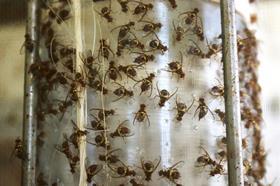
A unique control technique is being trialled in Perth's western suburbs in a bid to eradicate any remaining Queensland fruit fly (Qfly) from the area.
West Australian Department of Primary Industries and Regional Development (DPIRD) has been responding to an outbreak of Qfly since March this year, undertaking a programme including surveillance, fruit hygiene, mass trapping and baiting to eradicate the insect pest.
Over the next few weeks, the Sterile Insect Technique (SIT) will be trialled in the quarantine area to interrupt the breeding cycle of any Qfly remaining in the area.
Sterile Qfly will be released on a weekly basis to mate with any residual wild Qfly, resulting in infertile eggs and no future hatchings of fruit fly larvae. The sterile flies are dyed with a fluorescent powder which glows under UV light for easy identification.
DPIRD will assess the effectiveness of the programme by checking the traps in the Quarantine Area weekly and examining any adult Qfly found under a fluorescent microscope to determine if they are SIT or wild Qfly.
The SIT technology was used to successfully eradicate Qfly from an area covering approximately 800 square kilometres across Perth in 1990.
A quarantine area and movement restriction for fruit and vegetables remains in place for all or parts of Claremont, Nedlands, Dalkeith, Crawley, Mount Claremont, Cottesloe, Peppermint Grove, Swanbourne, Karrakatta and Shenton Park.
West Australian agriculture and food minister, Alannah MacTiernan, said the team had work tirelessly to control the pest.
“More than 120,000 property inspections have been completed, 250,000 host plants identified and close to 20,000 baiting and trapping devices deployed. And it is paying off,” said MacTiernan.
'Releasing sterile flies, while the Qfly population is very low, allows us to mop up any remaining wild Qfly in the outbreak area.
'A big thanks to the community and local governments for their co-operation and for continuing to abide by the quarantine movement restrictions on fresh produce. Keeping this pest out allows WA growers to continue to access important export markets, and we can have beautiful fruit at home,” she added.



